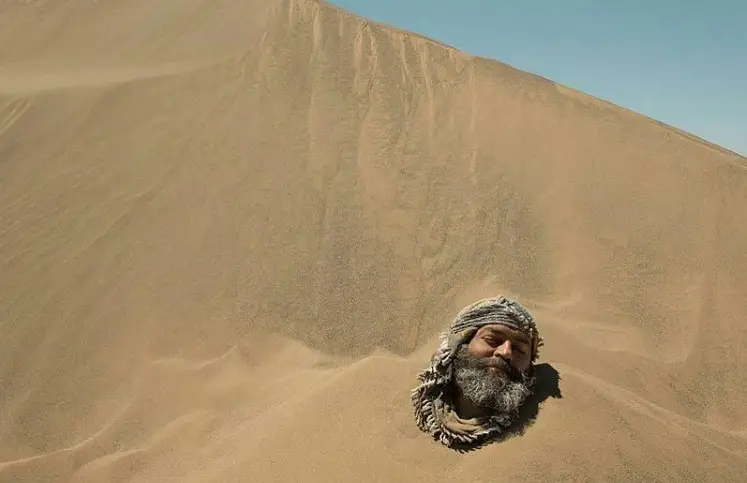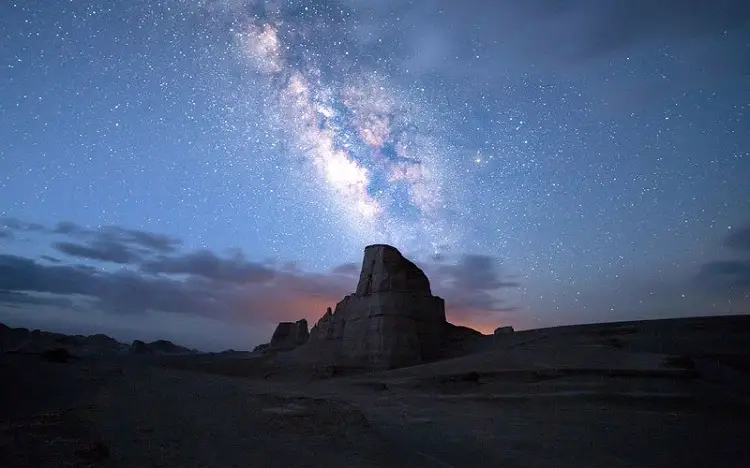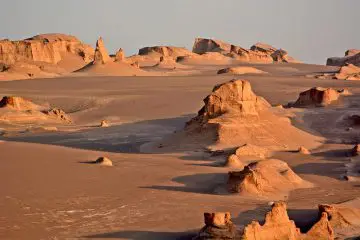Welcome to Lut Desert, one of the hottest and driest pieces of our beautiful planet. Stretching over a vast land in the southeast of Iran, this fascinating desert is known as the most pristine place in the country! In the local Beluchi language (a language common in southeast Iran), Lut means naked, arid, thirsty, and empty of anything. But this scorching and unfathomable place is not really empty! Sand dunes, gravel lands, impressive Kaluts (irregular landforms created by erosion), and constant geographical processes are parts of the reason this untouched land is a UNESCO Natural World Heritage. What makes this desert distinct from other deserts in the world is its impassability, its beautiful Shahdad Desert and that a part of it has a few times hold the record as the hottest place on earth. Stay with me for a discovery around this warm land.
Contents

Finding Lut Desert
Stretching over a land of 120 thousand square meters in southeast Iran, this vast desert covers almost 10 percent of Iran! Covering parts of 3 large provinces, Lut measures 900 km on its north-south side and 300 km on its west-east side. Almost 70 percent of this desert is in Kerman province, and the remaining 30 percent is a territory of South Khorasan and Sistan & Baluchestan provinces. The vastness of Lut Desert has blessed it with a variety of geographical features. But desert lovers usually choose known and popular routes for their adventure around this desert. One of the most popular spots on their itinerary is Shahdad Desert and the Kaluts of Kerman.
The Different Parts of Lut desert
Lut Desert is a low land with a variety of geographical features and differences in altitude. That’s why geologists divide it into 3 parts:
- Northern Lut:
The northern section of Lut desert, which is mainly a part of South Khorasan Province, is almost 500 to 1000 meters from sea level. This region is covered with sand , and the southern part of it includes irregular breaks that end in Birjand’s Shur River. What makes this region specially interesting is the existence of mountains, sedimentary hills, and volcanos that have made it prone to earthquakes.
- Central Lut
The most special part of Lut Desert is undoubtedly its central section. Known as Chale-ye Lut (meaning the Pit of Lut), this region has a 162-km length and a 52-km width. Huge masses of sand cover central Lut. There, you can also see salt and chalk deserts. Malek Mohammad Desert (to the west of Rig-e Yalan) is one of these deserts.
- Southern Lut
The southern part of Lut Desert stands out from the other parts with its special vegetation and precious heritages remaining from ancient civilizations. Known as ‘Lut-e Zangi Ahmad’, this section covers a large part of Kerman Province as well as the northern section of Sistan & Baluchestan Province.

The Attractions of Lut Desert
You might think a desert is nothing but a land of infinite heat and sand! But the truth is that it is the charms of a desert that are actually infinite. In its vast area, Lut Desert has hidden so many attractions:
1. The Kaluts of Shahdad
From a distance, the western section of Lut Desert looks like a whole other planet. But the unique structures you see there are neither manmade nor alien-made! These natural and geographical phenomena that can only be found in a desert are made over thousands of years by gradual erosion. These yardangs (or Kaluts in the local language) are irregular ridges of sand. As rare beauties in the world, the Kaluts cover a large area (145´80 km) of Lut desert (42 km to Shahdad Town) and make it a top natural attraction in Iran. Erosion caused by Shoor river and Sistan’s 120-day winds created these landforms. Mainly, it is the geographical and archaeological significance of the Kaluts of Shahdad that make Lut Desert so precious and put it in the UNESCO world heritage list.

2. Hamada Desert
With a large number of visitors, this part of Lut Desert extends from the Kaluts in the west to Rig-e Yalan in the east. Hamada desert is beautifully covered with small and big rocks that seem to be carefully placed together. That’s why it is known as the pavement of the desert. Wind and water erosion, and dramatic changes in temperature are the creators of this arid land.
3. Sand Dunes
In the eastern part of central Lut, a 50-thousand-hectare land is covered with sand dunes. Some of these hills reach up to 500 meters in height.
4. Nebka Trees
The wind is always blowing in the desert and it is always moving sand and soil from one place to another. But when a plant (usually Tamarix) grows in a corner of the desert, it blocks some of the sand and soil the wind is carrying and gathers them around itself. Over time, they form a circular shape around the bottom of the plant and give it a rare look. In Lut Desert, these vase-like structures have given a unique beauty to the bare landscape.

5. Tange-ye Roteyl (Tarantulas Gorge)
130 km from Shahdad, beside Khoshk Rud river, is the largest gorge in Lut Desert: Tarantulas Gorge. Although this gorge attracts ecotourists from around the world, it is still one of the most pristine pieces of Iran. As the name of the place suggests, this gorge is a home for one of the world’s most deadly and dangerous scorpions: sun spiders!
6. Gandom Beryan
Many sources call this section of Lut Desert the hottest place on earth! This 450-km-square-meter piece of land is indeed intolerably hot in summertime. But it is actually another part of Lut that was a few times recorded as the hottest place on earth. In summer, the temperature in Gandom Beyan reaches up to 70° C, making traveling to it impossible.

7. Kal Shoor river
It might be surprising that in a place as dry as Lut Desert, you can find a flowing river. But it’s true! In winter, the amazing Lut becomes host to seasonal rivers. Kal Shoor river is the main river that flows through this desert. The fame of this river comes from the salty and acidy water that makes it very dangerous. This is the same water that makes soil sticky and creates phenomena like Kaluts and nebkas.

8. The Nights of Lut Desert
Of the most incredible and special delights of the world are the shining nights of deserts. Detached from the busy world around it, Lut Desert also offers a peaceful silence and an otherworldly beauty to those who visit it at night. Spending the night in Lut Desert would be like drowning yourself in the peace of the meeting place of an ocean of stars and an ocean of sand. The clear air and the lack of light pollution also attracts sky watchers and astronomy lovers from around the world to this raw part of Iran.

Lut: A Treasury of Hidden Secrets
What makes Lut Desert different and unique is its deep historical roots and its unknown mysteries. It won’t be an exaggeration to say that none of the residents of this desert has traveled across it. It is this enigmatic nature of Lut and its inaccessibility that has led to the creation of a lot of legends and folklore around it
Although no human has ever stepped on parts of this wild land, archaeologists have found relics of ancient civilizations that are as old as 5000 years! Also, local folklore has always shown interest in the Kaluts of Shahdad. One of these local stories identifies the place with the biblical city of Lot. According to this story, the Kaluts are in fact the cursed people whom God turned into stone. The interesting point is that the pronunciation of the biblical figure, Lot, is exactly the same as the name of this desert.
Plus, some parts of Lut desert are so scorching that even bacteria can’t survive. Yet, in a region known as Zangi Ahmad, where there is no sign of life, you can find the remains of an ancient tower. It was around this place that archaeologists found clayware and pieces of colorful glass.
Like to go on an Adventure in Lut Desert?
Then hop on one of our Desert tours around Kerman.












Comments